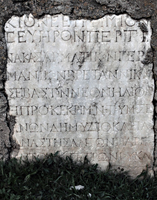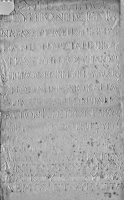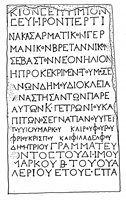 MAMA XI 157 (Moxeanoi)
MAMA XI 157 (Moxeanoi) 
Honorific statue base for Septimius Severus
- Type of monument:
- Honorific statue-base.
- Location:
- Doğla (Yazıtepe) (Moxeanoi): in a fountain (Yeni Çeşme), 1km WSW of the village.
- Description:
- Whitish marble block, originally the shaft of a large base, complete.
- Dimensions:
- Ht. 0.94; W. 0.54; Th. 0.46; letters 0.025-0.035.
- Record:
- Squeeze; drawing; MB notebook copy (1955/91); photograph (CVC 2011).
- Publication:
- Ramsay 1883: 422-3, no. 34 (from a copy by J.R.S. Sterrett, 1883); Ramsay, Phrygia II 660, no. 615 (from a copy by Ramsay, 1887); [IGR IV 664].
- Date:
- AD 196/7 (Year 281 of Sullan era)
⸤[Αὐτοκράτορα Καίσαρα Λεύ]⸥-
⸤κιον Σεπ̣τ̣ί̣μιον⸥
⸤Σευῆρον Περτί⸥-
⸤νακα⸥ Σαρματικὸν Γερ-
μανικὸν Βρεταννικὸν̣
5Σεβαστόν ⸤Νέον Ἥλιον⸥
⸤ἡ προκεκριμένη⸥ τοῦ Μοξε-
α̣νῶν δήμου ⸤Διόκλεια⸥·
ἀ̣ναστησάντων παρ’ ἑ-
αυτῶν Κ(οΐντου) Πετρωνίου Κα-
10πίτωνος Ἐγνατιανοῦ ὑπὲρ̣
τ̣οῦ υἱοῦ Μάρκου vac. καὶ Ῥούφου Ῥου-
φρίου Κρίσπου vac. καὶ Φιλαδέλφου
Δημητρίου· ⟨γραμματεύ-
οντος τοῦ δήμου
15Μάρκου β´ τοῦ Οὐα-
λερίου· ἔτους · σπα´⟩
Line 4: Βρετανικὸν Ramsay 1883; ‘My [1887] copy (made very carelessly) has Βρεταννικὸν and γραμματευόντων; but I follow Sterrett in both cases’, Ramsay, Phrygia II 660, n. 1.
⸤Diokleia, judged to preside over⸥ the people of the Moxeanoi, (set up the statue of) ⸤[Imperator Caesar Lu]cius Septimius Severus Pertinax⸥ Sarmaticus Germanicus Britannicus Augustus, ⸤New Helios⸥. (The statue) was set up at their own expense by Q. Petronius Capito Egnatianus, on behalf of his son Marcus, and by Rufus Rufrius Crispus and Philadelphos, son of Demetrios. ⟨Marcus, son of Marcus, grandson of Valerius, was secretary of the demos. Year 281.⟩






The stone appears to be complete, and hence the beginning of the imperial titulature was presumably originally inscribed on a separate upper moulding. The extant titulature in lines 1-5 is a curious conflation of two different emperors. The victory titles Sarmaticus Germanicus Britannicus (lines 3-4) can only pertain to Commodus (AD 184-192, Kienast 1996: 147-51); however, the remainder of the name and titulature, [Imperator Caesar Lu]cius Septimius Severus Pertinax... Neos Helios, clearly refers to Septimius Severus. Hence Ramsay, Phrygia II 660 notes that ‘The titles of Commodus are here transferred to Severus’ (cf. IGR IV 664: ‘nomina Commodi errore translata sunt ad Severum’).
In fact, as Ballance’s squeeze of this inscription reveals, the history of this monument is considerably more complicated and interesting than that. The inscription was originally cut in a highly distinctive hand, with wide interlinear spaces, very small omicrons, and four-bar sigmas. The surviving original parts of the inscription are as follows: (1) lines 3-5, Σαρματικὸν Γερμανικὸν Βρεταννικὸν̣ Σεβαστόν; (2) lines 6-7, τοῦ Μοξεα̣νῶν δήμου; (3) lines 8-13, ἀ̣ναστησάντων... Δημητρίου. (Lines 11-13, although inscribed in smaller letters, are recognisably in the same original hand.) At a later date, the original text in lines 1-3, 5-6, and the end of line 7 was carefully erased. A second hand, with large omicrons and square sigmas, then inserted a different imperial titulature in lines 1-3 and at the end of line 5, and made further alterations to the text at the start of line 6 and the end of line 7. The final four lines (lines 13-16) were also added in this second hand, although this apparently did not involve the erasure of any original text. The second hand is particularly obvious in lines 1-2 and 13-16, where the letters are considerably larger (and the interlinear spaces much smaller) than in the remainder of the inscription.
The rationale behind the erasure and re-inscription of lines 1-5 is obvious enough. After Commodus’ murder on December 31 AD 192, he suffered damnatio memoriae; his name was to be erased from all private and public monuments, and statues pulled down and destroyed (HA Comm. 18.12-13, 20.4-5; Varner 2004: 136-55). The damnatio effectively lasted only three months, since his memory was reinstated later the same year by Didius Julianus; in AD 197, he was deified by Septimius Severus. Nonetheless, there is abundant evidence that his images were deliberately mutilated throughout the empire: just to the west of Diokleia, at Silandos in north-eastern Lydia, his portrait was erased from a local bronze coin (RPC IV (http://rpc.ashmus.ox.ac.uk) 1492, #3, Berlin).
Inscriptions in which Commodus’ name has been erased are very numerous. In a very few cases, as on our monument, his name has been replaced by that of Septimius Severus: see (1) ILS 5465 (Gordon and Gordon 1958-65: II 159-61, no. 252), a private dedication from Portus of a statue of Hercules on behalf of the emperor Commodus, subsequently changed to Septimius Severus; (2) IRT 396, an inscription recording the restoration of the Hadrianic baths at Lepcis Magna by a local civic magnate, in honour originally of Commodus, subsequently (after AD 198) altered to Septimius Severus and the imperial family. It is difficult to say what might have led to the permanent displacement of Commodus’ name in these cases, since there are other examples in which his name is restored where it had previously been erased: see e.g. I.Ephesos 287 (1) and 288 (1), with Merkelbach 1979 (statue-bases for Commodus, restored under Septimius Severus with expanded titulature). Similarly, there seems to have been some ambiguity in the status of provincial temples of the imperial cult under Commodus: Tarsos appears never to have lost the title neokoros (Burrell 2004: 213-7), while Laodikeia on the Lykos seems to have been ‘downgraded’ for a period, with its neokoria of Commodus being restored only during the reign of Caracalla (Robert 1969: 281-9; Burrell 2004: 119-25).
This statue-base must reflect the change of imperial regime: a monument originally set up in honour of Commodus (AD 184-192) was subsequently re-used as a base for a statue of Septimius Severus in AD 196/7 (as indicated by the date in line 16: for the use of the Sullan era at Diokleia, see Leschhorn 1993: 267). It is more difficult to explain the alterations which appear to have been made in lines 6-7. Only the phrase τοῦ Μοξεανῶν δήμου survives from the original text of the inscription; the term δῆμος here signifies an autonomous rural collectivity without polis-status (Schuler 1998: 41-5). The name of the city of Diokleia (Διόκλεια, line 7), and the participle stating its primacy within the demos of the Moxeanoi (ἡ προκεκριμένη, line 6), were inscribed over erasures at the same time as the alteration of the imperial titulature in lines 1-5. Little can now be read of the original text at the start of line 6 and the end of line 7, although there appear to be the traces of a sigma beneath the first letter of the word Διόκλεια.
The only possible explanation for these alterations is that the relative statuses of the two communities concerned, Diokleia and the demos of the Moxeanoi, must have changed between the time of the original erection of the monument under Commodus and its re-use under Septimius Severus in AD 196/7. In the early third century AD, two cities are known to have existed within the wider ethnic unit of the Moxeanoi, namely Diokleia and Siocharax. Each of the two communities issued coinage on a single occasion: Siocharax minted a small issue under Septimius Severus in AD 202-5 (Aulock 1980: 90-1 and 154-5, nos. 899-907: Σιοχαρακειτῶν Μοξεανῶν), while Diokleia minted an equally small issue under Elagabalus (Aulock 1980: 51-3, 106-7, nos. 251-8: Διοκλεανῶν Μοξεανῶν). However, to judge from the Flavian conventus-inscription from Ephesos, neither community seems to have possessed civic status in the early Roman imperial period; here, the Μοξοανοί (sic) are listed as a single rural collectivity (I.Ephesos 13 II.35; Habicht 1975: 86). Habicht reasonably infers that Diokleia and Siocharax must have been granted civic status at some point between the Flavian period and Severus’ reign.
I conclude that the changes made to lines 6-7 of the inscription in AD 196/7 reflect a grant of civic status to Diokleia and Siocharax by Septimius Severus in the mid-190s. The title assigned to Diokleia (ἡ προκεκριμένη τοῦ Μοξεανῶν δήμου) ought then to indicate a novel claim to primacy over Siocharax within the wider ethnic grouping of the Moxeanoi. In particular, the participle προκεκριμένη ought to indicate that Diokleia has been ‘judged’ (κεκριμένη) (sc. by the Roman authorities) to be the ‘leading’ (προ-) civic community within the wider demos of the Moxeanoi. For the use of the verb κρίνειν in this context, compare the titulature of Nikaia in Bithynia, ἡ μητρόπολις κατὰ τὰ κρίματα τῶν Αὐτοκρατόρων καὶ τῆς ἱερᾶς συγκλήτου: I.Iznik 29-30; Heller 2006: 197-200.
A close parallel here is provided by another rural district immediately to the west of the Moxeanoi. An inscription of the late Hellenistic period informs us of the existence in eastern Lydia of a rural community known as ὁ περὶ Μοκαδα δῆμος (SEG 33, 1004); the Μοκαδηνοί reappear as a non-civic rural collectivity in the Flavian conventus-list (I.Ephesos 13 I.4-5; Habicht 1975: 66 and 72). The emergence of civic bronze coinage suggests that three village communities among the Mokadenoi, Temenouthyrai, Silandos, Bagis, all received civic status during the reign of Domitian. Subsequently, two different communities in the region, Silandos and Temenouthyrai, claimed to be the metropolis of Mokadene (TAM V 1 47a and IGR IV 618). It is not clear whether the title was transferred from one city to the other, or whether both laid claim to it simultaneously (Herrmann, TAM V, 1 p.1; on civic rivalries in the Greek east over the title metropolis, see Puech 2004).
It is hard to judge the geographical extent of the Moxeanoi; they appear to have occupied the hill-country that separated the territories of Akmoneia to the west and north-west, Kidyessos to the north-east, Sebaste to the south-west, and Brouzos and Eukarpia to the south-east. Diokleia seems to have been situated at modern Yeşilhisar, formerly Ahırhisar: see MAMA VI, xvi-xviii; Robert, Hellenica X, 120-1 n.5; Drew-Bear 1980a: 937-8; TIB Phrygien 233-4, s.v. Diokleia. It is conceivable that the name Doğla (Yazıtepe) echoes the ancient name Diokleia (Drew-Bear 1980a: 938). The location of Siocharax is unknown (TIB Phrygien 383-4, s.v. Siocharax).
The original text of lines 6-7 is difficult to recover. The genitive phrase τοῦ Μοξεα̣νῶν δήμου could depend on a different honouring group in the nominative (e.g. οἱ ἄρχοντες, οἱ γεραῖοι); alternatively, the honouring group may not be mentioned at all, and τοῦ Μοξεα̣νῶν δήμου could be part of a phrase describing Commodus (e.g. 〚τὸν τῆς οἰκουμένης καὶ〛 τοῦ Μοξεα̣νῶν δήμου 〚σωτῆρα〛 vel sim.).
The first of the three individuals responsible for erecting the original statue of Commodus, Q. Petronius Capito Egnatianus (lines 9-10), was descended from two long-established Italian families in the region, the Petronii and Egnatii: see further MAMA XI 102 (1955/102: Akmoneia), and especially MAMA XI 66 (1956/34: Dioskome/Sebaste), where we see members of both families collaborating on a monument dedicated to Philip the Arab. The cognomen Egnatianus derives from Petronius’ mother’s nomen Egnatia (Salomies 1992: 61 n.2). The rare gentilician Rufrius (lines 11-12) is also attested in this region on a doorstone of the late second century AD (Λούκιος Ῥούφριος: MAMA VI 356 = Waelkens 1986: 178, no. 443); the name is of Umbrian origin, and once again we are presumably dealing with dependents or freedmen of an Italian family. It is likely enough that the final three and a half lines of the inscription (γραμματεύοντος τοῦ δήμου Μάρκου β´ τοῦ Οὐαλερίου· ἔτους · σπα΄), added in AD 196/7, reflect the emergence of formal civic institutions at Diokleia (including a γραμματεὺς τοῦ δήμου) after the grant of civic status by Septimius Severus in the mid-190s.
The original monument to Commodus can be conjecturally reconstructed as follows:
[〚Αὐτοκράτορα Καίσαρα〛]
〚Μᾶρκον Αὐρήλιον〛
〚Κόμμοδον Ἀντωνεῖ〛-
〚νον〛 Σαρματικὸν Γερ-
5μανικὸν Βρεταννικὸν̣
Σεβαστόν 〚(e.g.) τὸν τῆς οἰ〛-
〚κουμένης καὶ〛 τοῦ Μοξε-
α̣νῶν δήμου 〚σωτῆρα〛·
ἀ̣ναστησάντων παρ’ ἑ-
10αυτῶν Κ(όϊντος) Πετρωνίου Κα-
πίτωνος Ἐγνατιανοῦ ὑπὲρ
τ̣οῦ υἱοῦ Μάρκου vac. καὶ Ῥούφου Ῥου-
φρίου Κρίσπου vac. καὶ Φιλαδέλφου
Δημητρίου.
In April 2011, the stone was still visible, mortared into the wall of the mosque garden at Doğla (Yazıtepe).